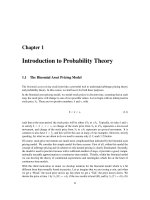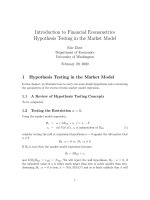introduction to Intracellula compartments
Bạn đang xem bản rút gọn của tài liệu. Xem và tải ngay bản đầy đủ của tài liệu tại đây (1.77 MB, 46 trang )
Cell Biology Course
Intracellula Compartments
PhD. Nguyen, Lai Thanh
Dept of Cytoloty, Histology, Embyology and Biophysics
Hanoi -11/03/2013
Objectives
Type of prokaryote intracellular compartments
Structure and function of ER, Golgi, Endosome, Lysosome, Peroxisome.
Exocytosis, Endocytosis, and Phagocytosis
Cellular Organelles
Cytoplasm of eukaryotic cells contain a network of interconnecting membranes. These
membranes enclose a lumen. This extensive structure is called endoplasmic reticulum.
It consists of membranes with smooth appearance in some areas and rough appearance in
some areasSmooth endoplasmic reticulum and rough endoplasmic reticulum.
In this lumen newly synthesized proteins are modified.
Rough appearance is due to the presence of ribosomes attached on its outer side.
These ribosomes are involved in the biosynthesis of proteins.
These proteins are either incorporated into the membranes or into the organelles.
Special proteins are present so called CHAPERONES. Theses proteins play a role in proper
folding of proteins.
Protein glycosylation also occurs in ER, for example, the carbohydrates are attached to the
newly synthesized proteins.
Smooth endoplasmic reticulum is involved in lipid synthesis.
Cholesterol synthesis
Steroid hormones synthesis.
Detoxification of endogenous and exogenous substances.
ER along with Golgi apparatus is involved in the synthesis of other organelles –lysosomes
& Peroxisomes.
Elongation of fatty acids
Desaturation of fatty acids.
ER connect to Nuclear Envelope
Golgi Apparatus (Complex)
Of what does the Golgi consist?
Golgi complex is a network of flattened
smooth membranous sacs- cisternae and
vesicles.
These are responsible for the secretion of
proteins from the cells(hormones, plasma
proteins, and digestive enzymes).
It works in combination with ER.
From the ER, secreted and membrane proteins move to the Golgi, a series of membrane-bound compartments found near the
nucleus
Golgi
nucleus
Enzymes in golgi complex transfer carbohydrate units to proteins to form of glycoporoteins,
this determines the ultimate destination of proteins.
Golgi is the major site for the synthesis of new membrane, lysosomes and peroxisomes.
It plays two major roles in the membrane synthesis:
i.
It is involved in the processing of oligosaccharide chains of the membranes (all parts of
the GA participates).
ii.
It is involved in the sorting of various proteins prior to their delivery (Trans Golgi
network).
Protein Sorting
Protein Sorting
These are responsible for the intracellular digestion of both intra and extracellular
substances.
They have a single limiting membrane.
They have an acidic pH- 5
They have a group of enzymes called Hydrolases.
The enzyme content varies in different tissues according to the requirement of tissues or the
metabolic activity of the tissue.
Lysosomal membrane is impermeable and specific translocators are required.
Vesicles containing external material fuses with lysosomes, form primary vesicles and then
secondary vesicles or digestive vacoules.
Lysosomes are also involved in autophagy.
Products of lysosomal digestion are released and reutilised.
Indigestible material accumulates in the vesicles called residual bodies and their material is
removed by exocytosis.
Some residual bodies in non dividing cells contain a high amount of a pigmented substance
called Lipofuscin.
In some genetic disease individual lysosomal enzymes are missing and this lead to the
accumulation of that particular substance.
Such lysosomes gets enlarged and they interfere the normal function of the cell.
Such diseases are called lysosomal storage diseases
Most impt is I-cell disease.
Sbility to produce or utilize H2O2.
They are small, oval or spherical in shape.
They have a fine network of tubules in their matrix.
About 50 enzymes have been identified.
The number of enzymes varies according to the function of the cells.
Peroxisome features and functions
Have an important role in the breakdown of lipids, particularly long chain fatty
acids.
Synthesis of glycerolipids.
Synthesis of glycerol ether lipids.
Synthesis of bile (mật).
![[CEH V3] Introduction to Ethical Hacking](https://media.store123doc.com/images/document/13/ly/ap/medium_3ABUW8WdDH.jpg)








